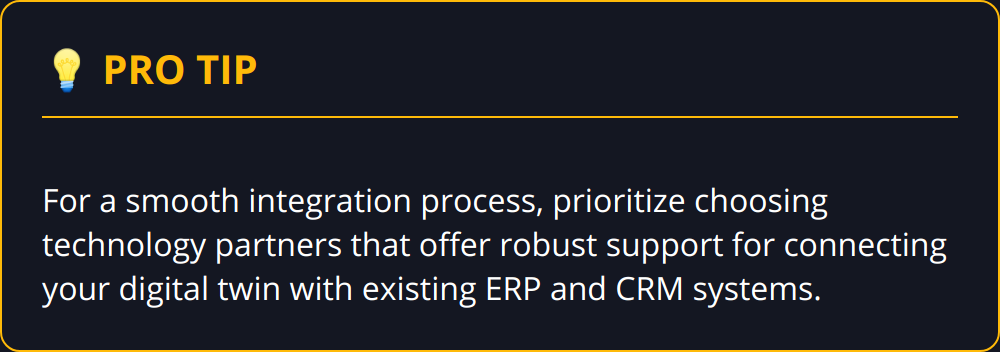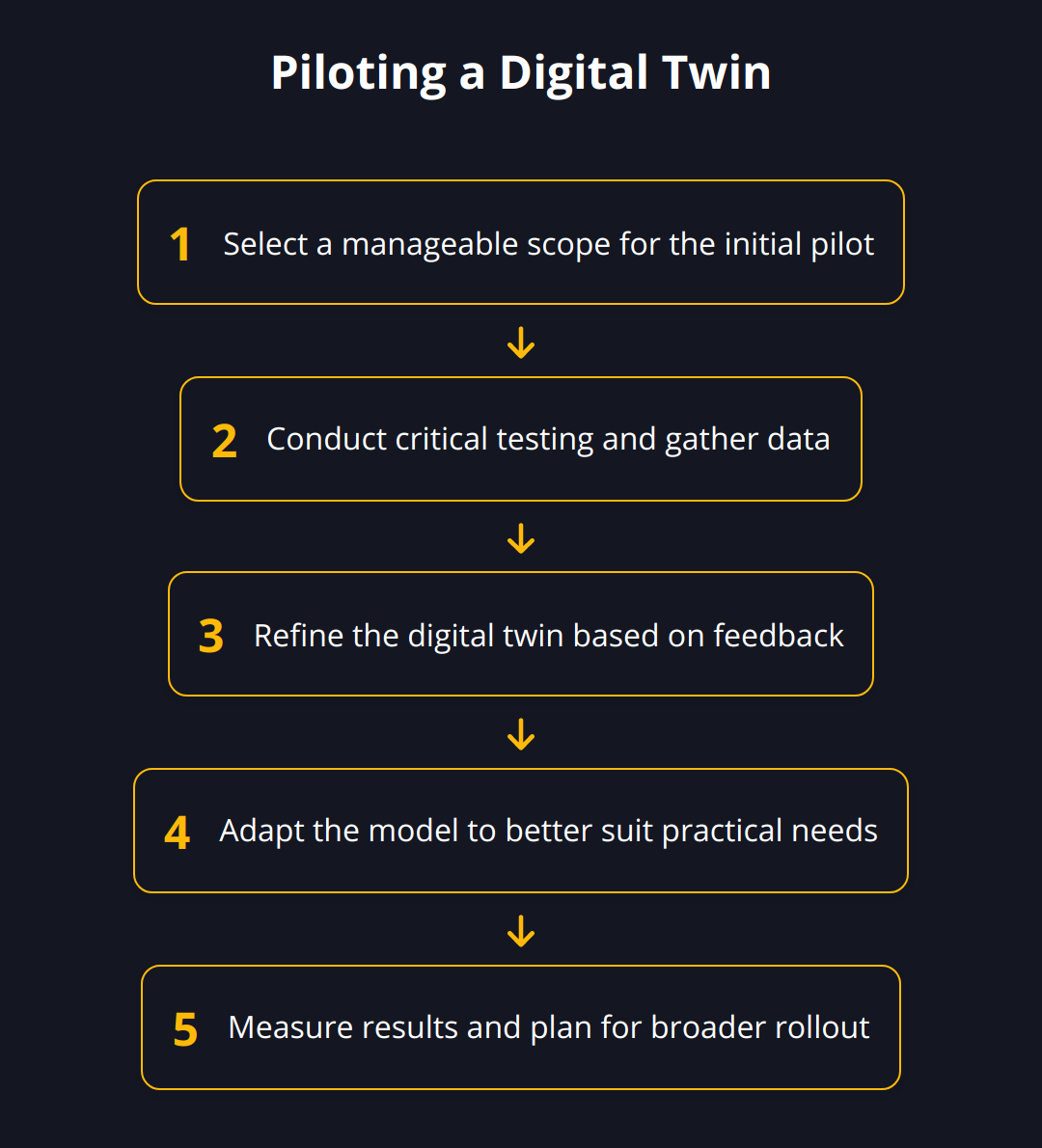We at Newroom Connect understand that building a digital twin is not just about technology—it’s about leveraging that technology to mirror and enhance your business processes. Each organization has unique demands, and a one-size-fits-all solution simply won’t cut it.
To navigate this complex landscape, we’re offering pro tips on creating a custom digital twin that truly fits your company’s needs. From initial assessment to final implementation, our guide lays out a clear path to a successful digital twin strategy.
Crafting Your Digital Twin Strategy
Creating a digital twin that aligns with your business requires in-depth analysis and a thoughtful strategy. Jumping into digital twin creation without a solid understanding of your business needs is a common pitfall that can lead to inefficient outcomes and wasted investment.
Firstly, a thorough assessment of your current business processes and operations is indispensable. You need to document and understand every workflow, every piece of machinery, every touchpoint that keeps your business running. This isn’t about overhauling your system on a whim; it’s about pinpointing where a digital twin can make your processes more efficient and your decisions more data-driven.

Next, let’s be honest about the barriers you’re facing. Is it a bottleneck in production, a quality control issue, or a shortfall in predictive maintenance? Being clear about specific challenges allows you to tailor a digital twin with precision, targeting those areas that will drive the most impactful outcomes. For operational roadblocks, a digital twin’s predictive capabilities can be a game-changer. For quality issues, digital twins excel at delivering real-time monitoring and testing of products under various conditions, which can significantly raise your quality standards.
Metrics for success are the cornerstone of your digital twin’s value proposition. It’s essential to establish these early on, as they will guide the development process and provide a benchmark to measure the efficacy of your digital twin post-implementation. Consider factors like operational efficiency, reduced downtime, accuracy of predictive analytics, and overall cost savings. Successful digital twin use cases, such as those by General Electric or Siemens, often highlight significant improvements in these areas.

To wrap it all up, here are a few bold points to keep in mind:
-
Detailed examination of your current operations is non-negotiable
-
Precise identification of pain points ensures a purpose-built solution
-
Concrete metrics will outline your digital twin’s performance and ROI
Remember, embarking on the journey to incorporate a digital twin into your operations is more than a technological leap; it’s a strategic move that will redefine how you approach problems and implement solutions. For a deeper understanding of digital twin capabilities and their transformative power in particular sectors, explore our insights in manufacturing and digital twins. With a firm strategy in place, you’ll not only ride the wave of Industry 4.0 but also wield the tools to outpace the competition.
Selecting Technology for Your Digital Twin
When it comes to designing your digital twin strategy, selecting the right technology is imperative. A critical step is deciding on the right technology stack that can accommodate the size, complexity, and future growth of your digital twin. It’s not about grabbing the shiniest tools, but choosing the ones that fit your unique requirements.

Picking Platforms and Technologies
The choice of technology should empower your digital twin to deliver on its promises. It’s vital to opt for platforms that are renowned for scalability and robustness. According to research, systems that offer cloud-based services and advanced analytics are leading the way for efficient digital twin operations. For instance, cloud infrastructure is a game-changer, providing the agility and flexibility necessary for managing vast amounts of data that digital twins generate.
In addition, integrating Internet of Things (IoT) capabilities is non-negotiable for a functional digital twin, as these are the sensors and actuators that furnish real-time data. Furthermore, analytics and machine learning tools help in detecting patterns and forecasting scenarios, turning data into insights.
Selecting technologies that facilitate interconnectivity between your digital twin and existing systems reduces implementation friction. Opt for solutions that streamline the integration with ERP and CRM systems; the convenience this offers is significant.

Engaging the Right Experts
You’ve picked the technology, but who’s going to put it all together? Collaboration with the right vendors and experts is key. Experience and specialization matter greatly, and that’s why engaging domain-specific experts can make all the difference.
For expert guidance, exploring partnerships with firms like Siemens PLM can bring valuable insights, given their track record in pioneering digital twin technology.
Blueprint for Harmonious Integration
Last but not least, charting a blueprint for integration and future scalability is essential. A digital twin is not static; it evolves with your business. Here’s a condensed action plan for successful integration:
-
Assess Compatibility: Ensure technologies align with current infrastructure.
-
Plan for Scale: Build with expansion in mind—growth is the goal, after all.
-
Map Out Data Flow: Design pathways for data to move seamlessly.
-
Prioritize Security: With increased connectivity comes greater risk; safeguarding data is imperative.
-
Test Rigorously: Validation before full-scale rollout helps avoid costly errors.
-
Educate Teams: Knowledge transfer empowers your staff to effectively use the digital twin.
In crafting a well-conceived strategy, remember that a digital twin is a representation of your operations and is as effective as the data and technologies it is built upon. With the right blend of scalability, expertise, and future-proofing, your digital twin will not only reflect the present but also pave the way for future innovation and efficiency.
Ensuring Top-Notch Data
In the digital twin realm, data is the lifeblood. Substandard data delivers suboptimal results, which can lead to misguided business decisions. Prioritizing data quality is a strong opinion because it’s the foundation upon which all digital twin functionality is built. Begin with a rigorous process of data cleansing and validation to ensure the accuracy of the twin’s insights. Implementing standard protocols for data collection and storage will aid in creating a reliable database. This is vital, as even the most sophisticated analytics are useless without quality data.
Access to this high-grade data must be seamless. A digital twin demands a continuous feed of information to keep its virtual model in sync with the physical world. Hence, robust data infrastructure is essential and investments here pay dividends in the future performance of the twin. The integration of a solid data management platform ensures data is not just available but also actionable.
Building Collaborative Teams
Cross-departmental collaboration is the unsung hero of a digital twin’s success. Isolation leads to narrow perspectives, while collaboration breeds innovation. It’s essential that teams across the business, from IT to operations to management, work hand-in-hand to share insights and align the digital twin with organizational objectives. Break down silos and foster a culture where knowledge sharing is the norm because a digital twin impacts multiple facets of your company.
Collaborative efforts aren’t merely recommended — they are necessary. Consider establishing a dedicated task force, including key stakeholders from each department, to oversee the digital twin’s development and deployment. It’s this unity of purpose and multidisciplinary approach that turns a complex technology initiative into tangible business outcomes.
Piloting for Performance
Starting small and iterating is a proven approach to tackling complex projects like custom digital twins. Running pilot projects allows for critical testing, refinement, and adaptation without the risks associated with widescale deployment. It’s practical to identify a single process or a smaller subset of operations on which to test your digital twin initially.

Steer clear of the perfection trap — anticipate that iterations will be required, and that’s perfectly fine. This phase is where you’ll uncover optimization opportunities and perhaps some unexpected challenges. All of this is valuable feedback that informs the broader rollout. Through pilots, you’re able to measure impact against your preset metrics, adjusting course as you scale up your digital twin efforts.
In summary, best practices in implementing custom digital twins translate to:
-
Prizing Data Virtue: Clean and validated data for reliability
-
Enabling Access: Robust data infrastructure for continuous flow
-
Democratizing Insight: Encourage sharing and collaboration
-
Testing Smarter: Pilot projects point the way for scaling up
Moving forward, how can these practices be layered into your overall digital twin strategy? They are the building blocks that will support the more technical aspects discussed earlier, aligning your digital twin with business goals and ensuring smooth adoption. Keep these tips in mind as your organization moves closer to realizing the potential of digital twin technology.
Wrapping Up
Customization is paramount in leveraging digital twin technology since it aligns the virtual platform with the unique intricacies of your business. It’s the difference between a standard template and a solution that works specifically for you, delivering optimal results. Throughout this guide, we’ve emphasized the importance of a strategy that starts with a comprehensive understanding of your operations, proceeds with a selection of compatible and scalable technologies, and culminates with an implementation centered around quality data and collaborative efforts.
![Key Takeaways - Custom Digital Twins [Pro Tips]](https://newroom-connect.com/wp-content/uploads/2024/02/Custom-Digital-Twins-Pro-Tips-6-2024-02-07-083434.4322550000.png)
As we reflect on the pro tips provided, it’s evident that each piece of advice weaves into the next, creating a robust fabric for a successful digital twin: keen analysis, technological compatibility, data integrity, and interdepartmental teamwork. These are not mere suggestions but pivotal actions that will determine the impact your digital twin will have on streamlining processes, enhancing data-driven decision-making, and driving innovation.
The digital twin landscape is dynamic and requires a mindset geared toward continuous learning and strategy evolution. As businesses grow and technology advances, your digital twin should be adaptable to new functionalities and improved operational insights. It should be seen not only as a tool for the here and now but as a long-term partner in growth and resilience.
In the spirit of providing businesses with cutting-edge virtual solutions, we at Newroom Connect present you with the means to innovate. Our software platform, Newroom Connect, is where your journey toward impressive virtual events, showrooms, and e-learning environments begins. This platform stands as a testament to the power of digital customization, designed to deliver experiences that resonate with your audience and drive engagement.
To sum up:
-
Customization tailors technology for maximum efficiency
-
A solid strategy is the backbone of digital twin success
-
Quality data and teamwork infuse life into digital twins
-
Adaptability is key for future-proofing your digital twin
Selecting the right partner in this journey is just as important as the steps you take. Newroom Connect, powered by advanced engines and backed by expert support, is ready to help you implement a digital twin strategy that sets the stage for exceptional virtual experiences and sustainable business growth. Transform your digital engagement—let Newroom Connect be your gateway.


